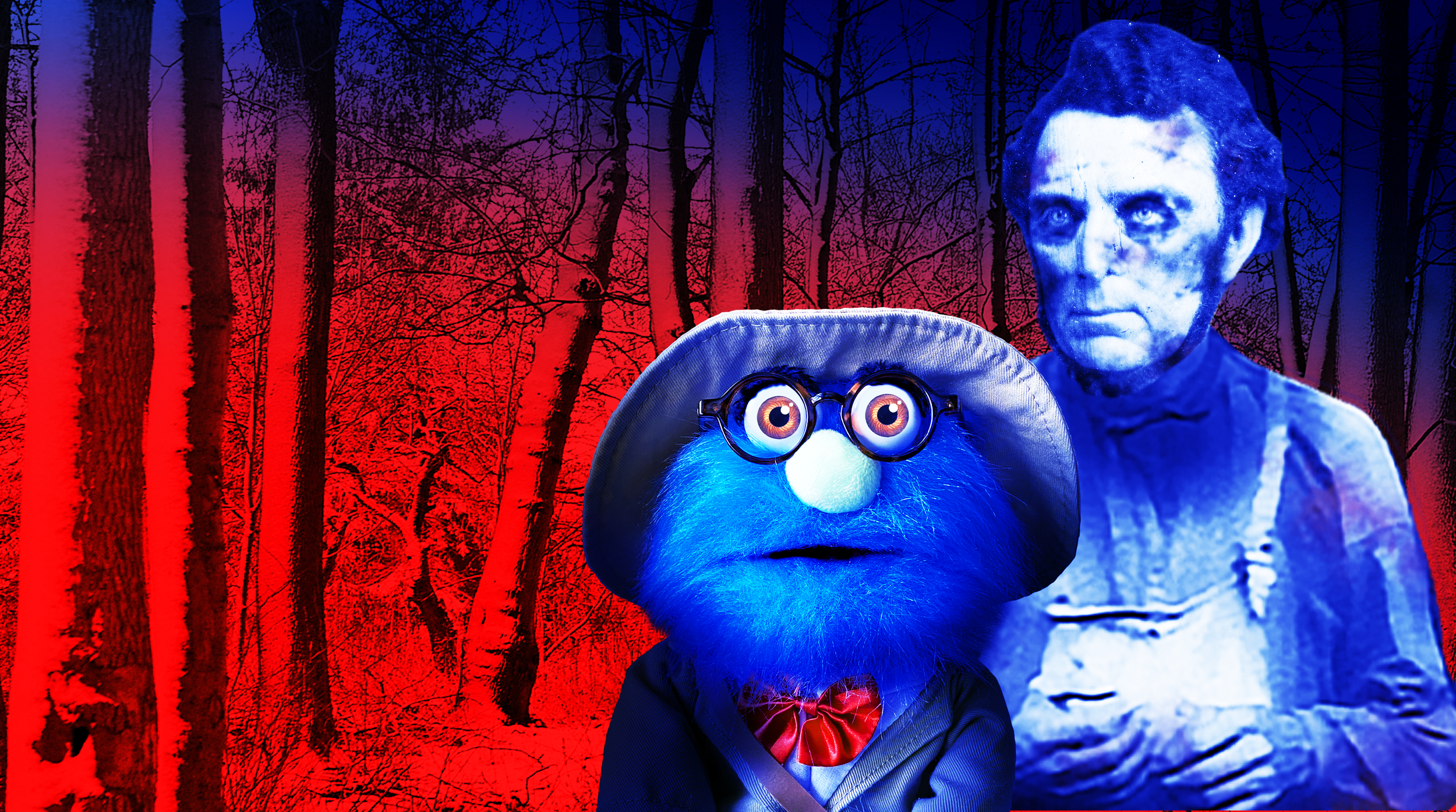
lesson 08 - The Grisly Journey of The Donner Party
Hello! And welcome to the FINALE of Puppet University, fall 2020. I’m your TA, writer and researcher Kari Koeppel, here to dive deeper into The Professor’s lesson of the week and to wrap things up for the semester!
There were so many great comments on last week’s episode about badass revolutionary Policarpa Salavarrieta — I learned a lot from you all. But this comment actually made me scream WHAT! out loud, because I had no idea.
Did anyone else (not from NJ) know that Joseph Bonaparte, older sibling of Napoleon and former temporary king of Spain, moved to Bordentown City, New Jersey in 1816 following his brother’s defeat?! He owned more than 1,800 acres in the area, and lived there until 1839 before moving back to Europe. The Professor nicknamed him Joey Bones in the episode, but apparently his nickname really was Joey Bottles, because he loved to drink (hilarious).
Now, onto the most notorious tragedy in westward expansion history: the Donner Party. Let’s start from the beginning. You may remember The Professor saying that the Donners and James Reed were from Springfield, Illinois, a town that probably rings a history bell. Who else was from Springfield that we covered this season? Oh, that’s right — our boy, Kate Warne’s old pal, Mr. Abraham Lincoln. What a funny coincidence! Except the coincidence runs deeper. Businessman James Reed had worked with a young lawyer Lincoln in the course of his business, and the two had become good friends. When Reed decided to set out west, Lincoln was interested in joining him. YES, how crazy is this: There was a chance that Lincoln and Mary Todd could’ve joined the Donner Party. This was 20ish years before his presidency, after all; imagine what would’ve been different in U.S. history! Lincoln was intrigued with the thought of California, and Mary had family out there. But at that point in time, they had a toddler and another baby on the way, and Lincoln had just embarked on his political career, so they decided not to go. But Mary Todd Lincoln was part of the group that waved the Donner party goodbye as they set off on their journey from Springfield. Much later, it was discovered that James Reed had taken papers with Lincoln’s handwriting on it with him on his journey to California. Even when he was banished from the group, he left the papers with his wife — so papers with Lincoln’s handwriting were present during the horrific events in the Sierra Nevada. How bonkers is that?!
Lansford Hastings, of Hastings’ Cutoff, was also more present than the Donners’ experience would’ve suggested. In fact, originally, the Donners were supposedto meet up with Hastings to be guided by the man himself through the route. But, as The Professor mentioned, the Donners were running late, and they missed his expedition. Stupidly, they decided to try it themselves. (To be fair, the group that was guided by Hastings didn’t have an easy time either, though it was nothing as catastrophic as the Donners’ experience.)
In the episode, Ryan asked The Professor: “How far were they into this shortcut when they realized, ‘oh, this road is pretty unsuitable, we have to fix it’?” The answer is: Pretty quickly, but not quite quick enough to turn back and go the established route. They had a great first week on the road, but it was within a fortnight that they hit those Wasatch Mountains. I’m sure they were just like, let’s just keep going, it’ll get better. But they had no idea what was ahead of them! A fun fact that I came across while researching this is that for over 90 years after the Donner Party’s trip across the Salt Flats of Utah, their wagon tracks remained visible, and artifacts that they’d left behind continued to be found. No one ever took Hastings Cutoff again after the Donner Party, but Mormon settlers coming to Utah the following year did follow their route to the Salt Lake Valley (but stopped there).
The Professor mentioned the incident (murder) that caused James Reed to be expelled from the Donner Party. But that was just one of several clashes between party members. Two days after Reed’s banishment, a Mr. Hardkoop was kicked out of Lewis Keseberg’s wagon (he of cannibalism fame). He was left on the side of the trail, and no one else in the party stopped to look for him. Another man, Wolfinger, stopped along the side of the road to bury some valuables; while he was doing that, he was murdered by two other men from the group,Joseph Reinhardt and Augustus Spitzer. And this was before they reached the Sierra Nevada. Lovely!
Once they did reach the Sierra Nevada site where they’d spend the next few months, snow was already on the ground and falling heavily. But they didn’tjust give up immediately. They arrived on Halloween, and between Nov. 1 until around Nov. 20, there were attempts to pass through the mountains. Author Ethan Rarick made a great point to U.S. News & World Report in 2008: “They kept thinking they would be able to get out, that maybe the snow would melt. Remember, these were people from the Midwest.” They just weren’t used to having 20 feet of snow on the ground, and didn’t know how to navigate it, or survive in it. Weather records show, however, that the winter of 1846-1847 was especially severe for the area. Luckily, there was already a cabin standing in the location; in fact, it’s why they chose that particular spot to stop. It had been built by members of the Townsend-Stephens-Murphy Party in 1844.
As for the whole, ya know, eating other humans thing. With the possible exception of Lewis Keseberg, all cannibalism was done to those who had died of natural causes, not murder, and they’d exhausted all other food options before they turned to this last desperate measure. The Forlorn Hope party resorted to cannibalism first, on Dec. 26, 1846, while those back at camp lasted until Feb. 26, 1847, after the first rescue group had come and gone. Author Michael Wallis told NPR in 2017, “They tried their best not to consume flesh of family members, they were so careful.” So, you know, there’s that. Fun(?) fact: According to a University of Brighton study, boars and beavers have about 1,800 calories into each pound of muscle, while a modern human contains just 650 calories. So like, FYI, humans aren’t the most calorie-rich food out there. Cool to know! But I guess the whole point is that boars and beavers (and other more normal animals to eat) weren’t readily available.
One aspect of the Donner Party’s story that only emerged in more recent years is the perspective of the area’s natives, the northern Washoe tribe (the Miwok people also lived nearby in the Sierra Nevada). Their oral tradition recalls that they were aware of the Donner Party’s presence, and even tried to help them, leaving rabbit meat and wild potatoes near the camps. When they tried to bring the Donner Party a deer carcass, they were shot at, so they didn’t try again. They then reportedly observed the group cannibalizing their dead, so then they were really like, “NVM, these psychos are on their own.” A fair reaction, if you ask me!!
There was one hero in the Donner Party’s rescue who stands out. There was an area, nicknamed “Starved Camp,” in a deep snow pit formed by the fire melting the snow down, perhaps twenty feet, to bare ground. Steps had been cut into the snowy walls of the pit. There, eleven living people, mostly children, were found among partially eaten dead bodies. On March 16, 1847, John Stark, an unpaid volunteer in the rescue party, single-handedly saved all eleven in Starved Camp, after other rescuers had thought they’d only be able to save two of them. James Breen, one of those in the pit at Starved Camp later said, “To his great bodily strength, and unexcelled courage, myself and others owe our lives. There was probably no other man in California at that time, who had the intelligence, determination, and what was absolutely necessary to have in that emergency.”
The opposite of a hero in that situation was Lewis Keseberg. The Professor described the grisly scene where he was found as the lone survivor in April 1847; when he finally arrived at Sutter’s Fort, Keseberg was accused of murdering Tamsen Donner, as she had been in good health when the third rescue team left. With no witnesses, however, a conviction was impossible. Keseberg’s innocence is still in question to this day, and there are reports that Keseberg later bragged about his cannibalism, remarking that human liver — especially that of Tamsen Donner — was the best food he’d ever eaten. But the story was also sensationalized in the press at the time, and Keseberg especiallygot a bad rap. He was nicknamed “The Human Cannibal,” and a journalist in the 1870s tracked Keseberg down to find him tormented by the accusations. By that point, he was widowed, poor, and caring after two mentally disabled daughters. (A German immigrant, Keseberg at some point introduced lager beerto the Sacramento area.) The journalist, C.F. McGlashan (who went on to author History of the Donner Party: A Tragedy of the Sierra, published in 1880), brought him together with Eliza Donner Houghton, a surviving daughter of Tamsen Donner. Keseberg reportedly dropped to his knees in front of Eliza, then stood, looked her in the eyes, and swore he had not murdered her mother (though he did not deny eating her posthumously). Eliza supposedly believed him. Later, though, his descendents would change the family name.
There are a surprising number of firsthand accounts from the surviving members of the Donner Party; there’s Patrick Breen’s journal, and Eliza (Donner) Houghton and Virgina Reed Murphy’s books. I highly, highly recommend giving them a perusal. They are WILD.
On a personal note! Perhaps this was morbid, but I went to Donner Memorial State Park last year!! It’s super close to north Lake Tahoe in northeastern California, if, post-pandemic, you’re ever in the area. It was fascinating; there’s a major highway (Interstate 80) that runs through Donner Pass now (which would’ve made rescue much easier). And there’s a great little museum on the site.
This disturbing quote greets you as you enter the museum.
CONGRATULATIONS!
You’ve completed the fall semester of Puppet University. You’ve learned about the first female detective, the graffiti in Pompeii, a forgotten female pharaoh, the worst Olympics ever, and a bitter rivalry between a genius and a counterfeiter; and heard the heartbreaking love song between two star-crossed oars. Hopefully your semester has been all the richer for it.




